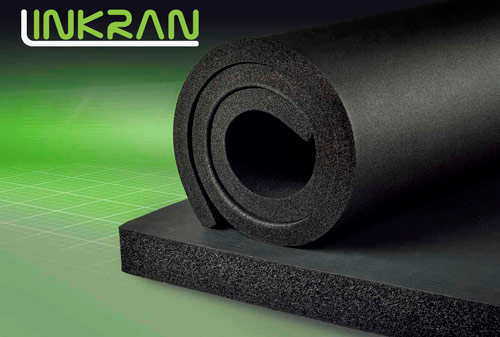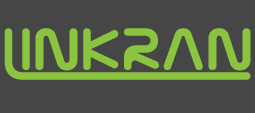INSULATION OPERATION - Installation LINKRAN Insulation
| عملیات عایق کاری - نصب عایق | Installing Insulation |
| حداکثر عملکرد حرارتی یا مقدار R (میزان مقاومت در برابر انتقال حرارت) عایق به نصب مناسب بستگی دارد. | The maximum thermal performance or R-value of insulation is very dependent on proper installation. |
| جدول زیر به معرفی نمای کلی بیشتر مواد موجود برای عایق کاری، محل نصب و مزایای آنها میپردازد. | The table below provides an overview of most available insulation materials, how they are installed, where they're typically installed, and their advantages. |

| ADVANTAGES | WHERE APPLICABLE | MATERIAL | TYPE |
| High insulating value for relatively little thickness.
Can block thermal short circuits when installed continuously over frames or joists. |
Unfinished walls, including foundation walls
Floors and ceilings
Unvented low-slope roofs |
Polystyrene
Polyisocyanurate
Polyurethane |
Foam board or rigid foam |
| Can withstand high temperatures. | Ducts in unconditioned spaces
Other places requiring insulation that can withstand high temperatures |
Fiberglass
Mineral (rock or slag) wool |
Rigid fibrous or fiber insulation |
| نوع | ماده | محل نصب | مزایا |
| عایق پنلی فومی یا فوم سفت | پلی استایرن
پلی ایزوسیانورات
پلی یورتان |
سطوح ناتمام شامل دیوارههای پایه، زمینها و سقفهای شیبدار بدون دریچه | حجم عایق بالا برای ضخامت نسبتا کم.
می تواند به طور مداوم مدارهای کوتاه حرارتی را هنگام نصب روی فریمها یا تیرچه ها مسدود کند. |
| عایق فیبری سفت یا عایق فیبری | پشم شیشه
پشم معدنی (سنگ یا سرباره) |
مجاری در فضاهای پیش بینی نشده
سایر مکان هایی که به عایق کاری نیاز دارند و مقاوم به درجه حرارت بالا هستند. |
تحمل در برابر حرارت بالا |
| عایق پنلی فومی یا فوم سفت
میتوان عایق پنلی فومی فوم را برای عایق کردن تقریبا هر قسمت از ساختمان از پشت بام تا پایه به کار برد. این عایقها برای پوشش دیوارههای بیرونی، پوشش داخلی دیوارههای زیرزمین و همچنین کاربردهای ویژه مانند دریچههای زیر شیروانی بسیار مؤثر هستند. مقاومت حرارتی این عایقها بسیار خوب بوده (تا حدود 2 برابر بیشتر از سایر مواد عایق با ضخامت یکسان)، و هدایت گرما از طریق عناصر سازه مانند میخهای چوبی و فولادی را کاهش می دهند. متداولترین مواد برای ساخت عایقهای پنلی پلیاستایرن، پلی ایزوسیانورات (پلیزو) و پلی اورتان میباشند. |
Foam Board or Rigid Foam
Foam boards -- rigid panels of insulation -- can be used to insulate almost any part of your home, from the roof down to the foundation. They are very effective in exterior wall sheathing, interior sheathing for basement walls, and special applications such as attic hatches. They provide good thermal resistance (up to 2 times greater than most other insulating materials of the same thickness), and reduce heat conduction through structural elements, like wood and steel studs. The most common types of materials used in making foam board include polystyrene, polyisocyanurate (polyiso), and polyurethane. |
| عایق پنلی فیبری سفت
عایق فیبری سفت یا عایق پنلی فیبری شامل مواد پشم شیشه و همچنین مواد پشم معدنی بوده و در درجه اول برای عایقکاری مجرای هوا در خانه ها استفاده می شود. در صورت نیاز به عایق کاری با میزان مقاومت حرارتی بالا نیزبه کار برده میشود. این محصولات در ضخامتهای مختلف از 1 اینچ تا5/2 اینچ موجود هستند. |
Rigid Fiber Board Insulation
Rigid fiber or fibrous board insulation consists of either fiberglass or mineral wool material and is primarily used for insulating air ducts in homes. It is also used when there's a need for insulation that can withstand high temperatures. These products come in a range of thicknesses from 1 inch to 2.5 inches. They can also use special weld pins with integral-cupped head washers |
| انواع عایق فومی
امروزه ، اکثرعایقهای فومی از مواد مضر برای لایه ازن مانند کلروفلوئوروکربن ها (CFC) یا هیدروکلرول فلوئوروکربن ها (HCFC) استفاده نمیکنند. دو نوع عایق فومی وجود دارد: سلول بسته و سلول باز. معمولا هر دواز پلی اورتان ساخته میشوند. در فوم سلول بسته، سلولهای با چگالی بالا بسته شده و پر از گاز میشوند. این کار به انبساط فوم کمک کرده تا فضاهای اطراف خود را پر کند. سلولهای فوم سلول باز چگالی بالایی ندارند و از هوا پر میشوند، به این صورت بافت عایق اسفنجی میشود انتخاب نوع عایق به نحوه استفاده و بودجه شما بستگی دارد. در حالی که مقدار مقاومت حرارتی فوم سلول بسته بیشتر است و همچنین مقاومت بیشتری در برابر رطوبت و نشت هوا دارد، مواد نیز متراکمتر بوده و هزینه نصب آن گرانتر است. فوم سلول باز سبکتر و کم هزینهتر است. نباید زیر سطحی که احتمال جذب آب در آن وجود دارد استفاده شود. برای انتخاب بهترین نوع عایق، با یک متخصص حرفهای مشورت کنید.
مواد موجود عایق فومی به شرح ذیل هستند:
سمنتی (سیمانی) فنلیک پلی ایزوسیانورات (پلیزو) پلی یورتان
|
Types of Foam Insulation
Today, most foam materials use foaming agents that don't use chlorofluorocarbons (CFCs) or hydrochlorofluorocarbons (HCFCs), which are harmful to the earth's ozone layer.
There are two types of foam-in-place insulation: closed-cell and open-cell. Both are typically made with polyurethane. With closed-cell foam, the high-density cells are closed and filled with a gas that helps the foam expand to fill the spaces around it. Open-cell foam cells are not as dense and are filled with air, which gives the insulation a spongy texture.
The type of insulation you should choose depends on how you will use it and on your budget. While closed-cell foam has a greater R-value and provides stronger resistance against moisture and air leakage, the material is also much denser and is more expensive to install. Open-cell foam is lighter and less expensive but should not be used below ground level where it could absorb water. Consult a professional insulation installer to decide what type of insulation is best for you.
Available foam insulation materials include:
Cementitious Phenolic Polyisocyanurate (polyiso) Polyurethane.
|
In case of being interested in studying about elastomeric insullation , it has been researched professionaly by LINKRAN.

Write a Comment